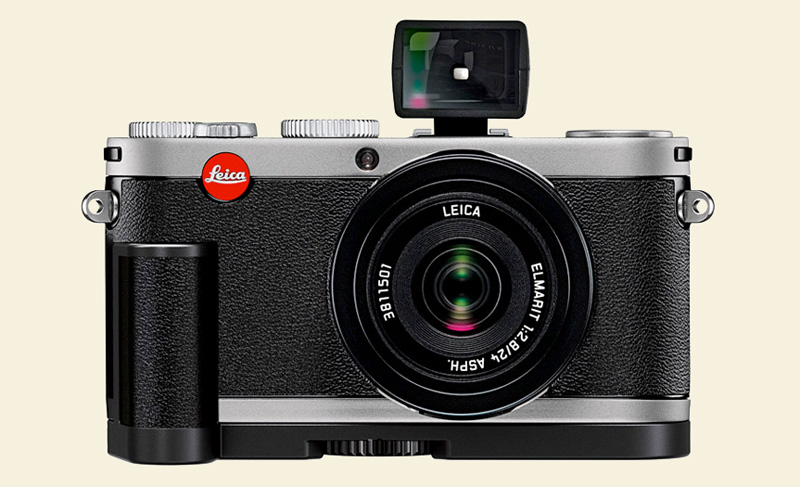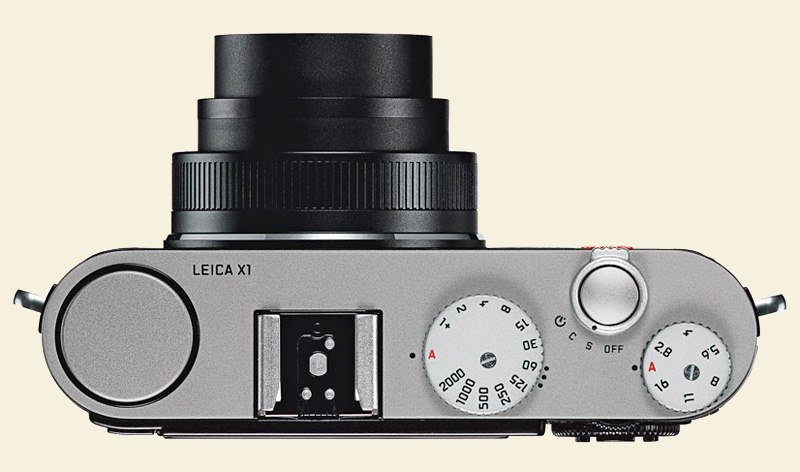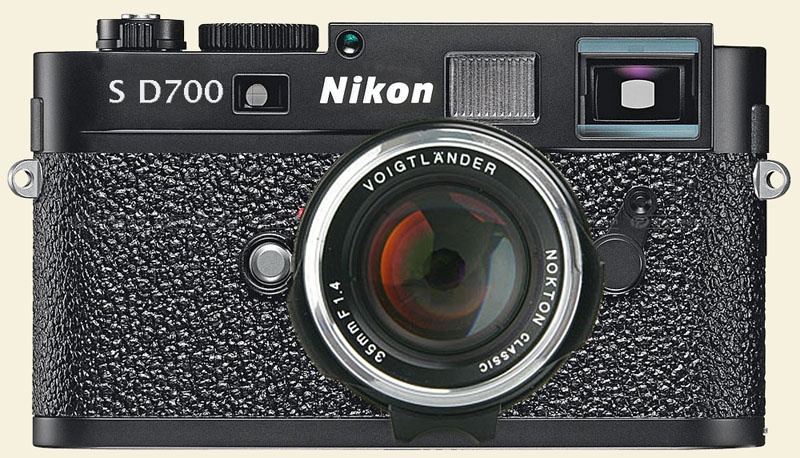Over the past handful of years we've reported that Leica has had its problems. Well, with a new team in place, a passel of smart new products, and (clearly) a dynamic intelligence behind its long-term strategic thinking, it's safe to say Leica's back.
In fact it may be in a better position now than it has been in twenty years. People forget that despite the strong brand identity of the M series legacy, the marque has been significantly at sea for a lot of years—rebranding this or that Japanese compact, struggling to bring out new but anachronistic products that turn out to be duds or dead-ends. Struggling with the great digital transition that killed Minolta, Konica, Contax, Bronica, Polaroid, and Rollei.
Well, no more. That era appears to be over.
 Leica AG President Rudi Spiller on the web podcast, which got underway at 9:15 in NYC
Leica AG President Rudi Spiller on the web podcast, which got underway at 9:15 in NYC
The big launch went well this morning. It was a few minutes late, but the technology worked. The presentation had some of the typical tiresomeness of its genre—the press function—but the execs and the celebrity presenter did a creditable job. Seal actually is a devoted Leica aficionado, too, for which I give Leica credit—his presence wasn't just ornamental.
Leica did a good job overall of leveraging this announcement for maximal coverage and buzz-generation. There's no question that interest over this launch was high and that lots of people got involved. Kudos to Leica for that, too.
More importantly, all three new products look well situated. I've written about my approval of the S System concept before, and the M9 seems like the full maturity of the digital M come round at last. (By the way, did you notice? There will be no "British Penalty" for the M9—at $6,995 and £4,850, according to dpreview, the US and UK prices are right in line with the exchange rate. Kudos again, Leica.)

The biggest surprise of this announcement week was the littlest camera—the $2,000 X1, due in early December. Perhaps predictably, I find myself drawn to it. It's a "right-sized" compact with what looks to be an intelligent layout. The mix of a 24mm (36mm-e) ƒ/2.8 lens and a 12-MP APS-C CMOS sensor seem "just right" in true Goldilocks fashion, and if the early reports of excellent speed and responsiveness turn out to be correct, the X1 just might turn out to be the best DMD yet, its lack of interchangeable lenses notwithstanding. (That choice makes sense in light of the M9, which is Leica's interchangeable lens offering.)
I like this view of the X1 the best. How nice to see such straightforward exposure controls, with P, A, S, and M so logically implemented. That alone makes me want to use this camera.
I won't keep you—I know you want to go off and read the reviews on the big camera-review sites. There will be M9, S2, and (I hope) X1 reviews and previews appearing all over the web all week long.
Leica's back. How about that?
Mike
Featured Comment by Jean-Pierre Grüter: "I would like to contribute a technical dream which is certainly not only mine. When I saw that Leica is using an 18-MP Kodak sensor I thought that the high ISO performance will be a problem. And it looks like this is true. On the attached picture you see what probably many photographers wish. May be one should contribute the microlens shift of the Kodak sensor to the D3/D700 sensor and it would be a camera for which I would pay $6,000."




I attended the product demo at my local camera store (Bergen County Camera, great dealer, BTW) last night. Jim Wagner from Leica was there. I got a chance to try out the S2 and the M9. I was very impressed by both.
The S2 seems only a little larger than an R8 and was very close in weight. The 70mm lens was bigger but lighter than an 80 f1.4 for the R cameras. The viewfinder was bright and easy to use and the camera comfortable to hold and handled very well.
The M9 had real Leica feel with a better viewfinder than my M6TTL. It's small, light, responsive with a very quiet shutter. Lots of ambient room noise so I couldn't tell if it was quieter than a film M, but it's very close.
I didn't try the X1 although it seemed to be drawing the most interest from the customers in the store. There was a lot of positive buzz about this camera.
I'm thinking that this is the first digital camera that I would actually like to own. Is it worth more than two 5D mk IIs? In my mind, Hell, yes! not even a contest.
More importantly, I'm now inclined to buy a third lens for my film Leica. The full frame M9 rollout today shows me a credible digital "upgrade" path that would make such an investment worthwhile.
Posted by: Tom Duffy | Thursday, 10 September 2009 at 12:21 PM
I think it's a little premature to say "Leica's back". It may turn out to be "too little, too late". With newspapers folding right and left and photojournalists finding it harder to get work, it is not at all clear to me who is going to shell out US$7k for the M9.
Nor is it clear to me that photographers are willing or able to pay a premium for the X1 over similar, cheaper competing formats, from Canon's G11 to Panasonic's GF1.
Don't forget, too, there's a recession on.
Posted by: kickstand | Thursday, 10 September 2009 at 12:37 PM
I am impressed!
The X1 reminds me of the Leica-I(A) of 1925, nothing wrong with that though... Somehow even similar to a FED... XD
Now Leica seems to have a range of:
-S2 - smallest medium-format camera
-M9 - smallest full-frame camera
-X1 - smallest APS-C camera
Splendid...
Posted by: Silver Bromide | Thursday, 10 September 2009 at 12:45 PM
I don't know if you've looked at the M9 brochure - it features photographs of Cuba. Is it just me or do these look like pictures that could be made with any low-priced point n' shoot? Some highlights blown out, others on the point of being blown out and a general look of overexposure - I know the Cuban sun is hot but the photographer had an M9- couldn't he ( or she) have done better? I've owned Leicas and I know the camera deserves its formidable reputation so I suspect it's not the camera but rather a bad decision at the editing table ...
Posted by: Mark L. Power | Thursday, 10 September 2009 at 01:24 PM
While a number of people have pointed out that there are other “full frame” digitals as expensive as the M9, these are often studio cameras. News and documentary photographer’s cameras are faced with breakage, theft and confiscation. Working abroad, specifically in the Middle East, Africa, China and the Soviet Union, I started not using my beloved Leicas and lenses because I wouldn’t be able to replace them.
Many of us (including one friend who has been field testing the M9 and loving it) don’t use a camera in a way that optimizes it’s quality. That probably included Bresson and Smith. The bright line finder with it’s ability to see beyond the frame and keep everything sharp, is ideal for anticipating the moment in situations you don’t control. That is a huge part of the rangefinder appeal for many Leica photographers. Right now I’m wondering if there is a place on top of the Canon S90 that I could epoxy an accessory shoe for my Leitz bright line finders.
Posted by: Bill Pierce | Thursday, 10 September 2009 at 02:35 PM
"Mike, Would you extend eligibility for the Leica Year to the X1?"
Not unless it has 18 millisecond shutter lag and a "fire priority" shutter, i.e., it takes a picture whenever you hit the shutter button regardless of whether it's ready or not.
Hate to be a stickler, but....
Mike
Posted by: Mike Johnston | Thursday, 10 September 2009 at 02:44 PM
Just coming back on the astonishingly low LCD pixel count of the M9 and X1. Browsing on this site I realized Ctein may have given the answer on 17 August:
"More pixels in the LCD means lousier image quality - poorer color, less contrast and lower brightness. At today's technology level, those 900k displays are nearly useless in sunlight. (...) I'll take 300k good pixels over 900k crappy ones any day; I get a more useful info from looking at the former."
Could it be Leica opted for better legibility in bright sunlight ? This wouldn't be a bad choice, especially for the X1 which lacks an optical viewfinder. This would make it even more suitable for street photography.
Posted by: CMS | Thursday, 10 September 2009 at 03:58 PM
Mark L, I'm the opposite about the Cuban photos. I thought they were excellent, not only the actual photos, but the IQ as well. I was actually pretty moved by them.
Posted by: Ben Mathis | Thursday, 10 September 2009 at 03:59 PM
I also have an LX-3 and really like it a lot. That being said, the one place where its use of a tiny little sensor betrays itself is that even at base ISO whatever they are doing to avoid too much noise also completely destroys edge sharpness and even at moderate pixel peeping levels.
True. I'm always surprised at the touch of noise the LX3 still has at ISO 80.
Ironically I like the LX3 at ISO 400 (where you don't expect noiseless photos) or so more than I like it at ISO 80.
And the RAW files aren't much better than the jpegs. They have no headroom and Silkypix blows.
But, that being said, I still think I'd rather have the 24-60mm lens than a fixed 36mm equivalent. I'm guessing that a pockatable camera with a 24-60mm lens and F2.0 at the wide end would be pretty difficult. I'm assuming that sometime over the next few years they'll be making APS sized compact zooms but with the horrifically slow apertures that film compacts had.
Interestinly enough, I find that composing photos with an LCD screen instead of through an SLR viewfinder often improves the way I frame my photos.
If I could have something as fast as an SLR without the SLR tunnel vision I'd be happy.
Oh wait, I guess that would be an M9.
Posted by: I'm Curious Grey Scale | Thursday, 10 September 2009 at 06:10 PM
From what I can discern the new cameras look fantastic, and we know how good the lenses are, so congratulations to Leica!
But wait, something bothers me. What about all the folks who purchased M8s and M8.2s? Who's going to want an APC-C sensor M camera when a full-frame version is now available? I hear folks saying they're still happy with their M8s and M8.2s, but are they really? And how could they be happy? It's pretty hard to admit that you've been taken for a ride. Just being able to use a 35 Summicron as a 35mm instead of as a normal lens is alone enough to want an M9, even without taking into account the imaging advantages of a full-frame sensor.
So you have to wonder if Leica should have waited until their full-frame M camera was ready and released it as an M8 instead of the M8 they did release. Should Leica customers be paying beta testers while waiting for the company to get their act together? I don't care how deep one's pockets are you'd have to resent Leica for basically flim-flamming their loyal customers into buying an M8 when they knew all along that the M9 is the camera they should have released as their first digital M camera, as an M8. But you know what, I don't think anyone is going to complain much, and that's what's really sad.
Posted by: Player | Thursday, 10 September 2009 at 06:52 PM
Calling the M8 a beta for the M9 is like calling the D2x a "beta" for the D3. Let's be real here. If Leica waits a few years because they "know" a full frame sensor is in the pipeline they might not have been around to actually put the camera out.
And that assumes the ludicrous notion that they "knew" what the pipeline was with that level of certainty. If you think the future is that clear maybe you should get a job running a camera company. You could make a lot of money.
Posted by: psu | Thursday, 10 September 2009 at 10:47 PM
The X1 camera is very cheap:
A Summarit 35mm f2.5 is $1600 - and for those that dont understand why a good lens costs so much, visit an optical manufacturer to see for your selves.
Which for me means the camera is about $400 - I know there is a half stop difference between summarit and elmarit.
If I didnt have the G1, I would order now, but I shall simply wait until my G1 falls down and breaks :-)
Ravi
Posted by: Ravi Bindra | Friday, 11 September 2009 at 12:55 AM
The other thing that surprises me - arent't the Japanese the leaders in miniturisation? In which case why are their full frame cameras bigger than a M9 and why is a Leica S2 with larger sensor the same size as the pro FF cameras? Or how does Leica get so much into a small package and isnt that worth paying for?
Posted by: Ravi Bindra | Friday, 11 September 2009 at 01:39 AM
psu,
The Canon full-frame EOS-1Ds was available for sale (not just in development)in the spring of 2003, and the full-frame 5D in August of 2005. Pentax had announced at Photokina, as far back as September of 2000, the prototype MZ-D with the same sensor as the Contax N Digital (which was released to the public in 2002).
The Leica M8 was released in September of 2006, and the future was clear as can be long before then.
Posted by: Player | Friday, 11 September 2009 at 04:03 AM
Player: Not sure what your point is.
Full-frame sensors have been around pretty much all along. It doesn't mean that it was practical to put them in a M8-type camera 3 years ago.
The Contax N Digital essentially killed off Contax, and if anything, Pentax was smart enough to pull the plug on the MZ-D before it killed them, so this may actually be the perfect counter-example.
Posted by: Cyril | Saturday, 12 September 2009 at 01:15 PM
"There will be no "British Penalty" for the M9—at $6,995 and £4,850, according to dpreview, the US and UK prices are right in line with the exchange rate. Kudos again, Leica."
No kudos for Leica from Australia. We have to pay Australian $10,500 (plus 10% GST = $11,550). At today's exchange rate thats US$9065. An "Aussie Penalty" of US$2000!
Posted by: Iain Dawson | Saturday, 12 September 2009 at 05:44 PM
I think I just saw pigs fly.
35mm is the focal length I prefer (40mm at the most) and I like hard-mounted controls. I'd love to hear first-hand impressions of how the X1 responds (i.e. how quickly it shoots in MF mode, how much shutter lag there is, etc.)
Posted by: Allen George | Sunday, 13 September 2009 at 07:55 PM